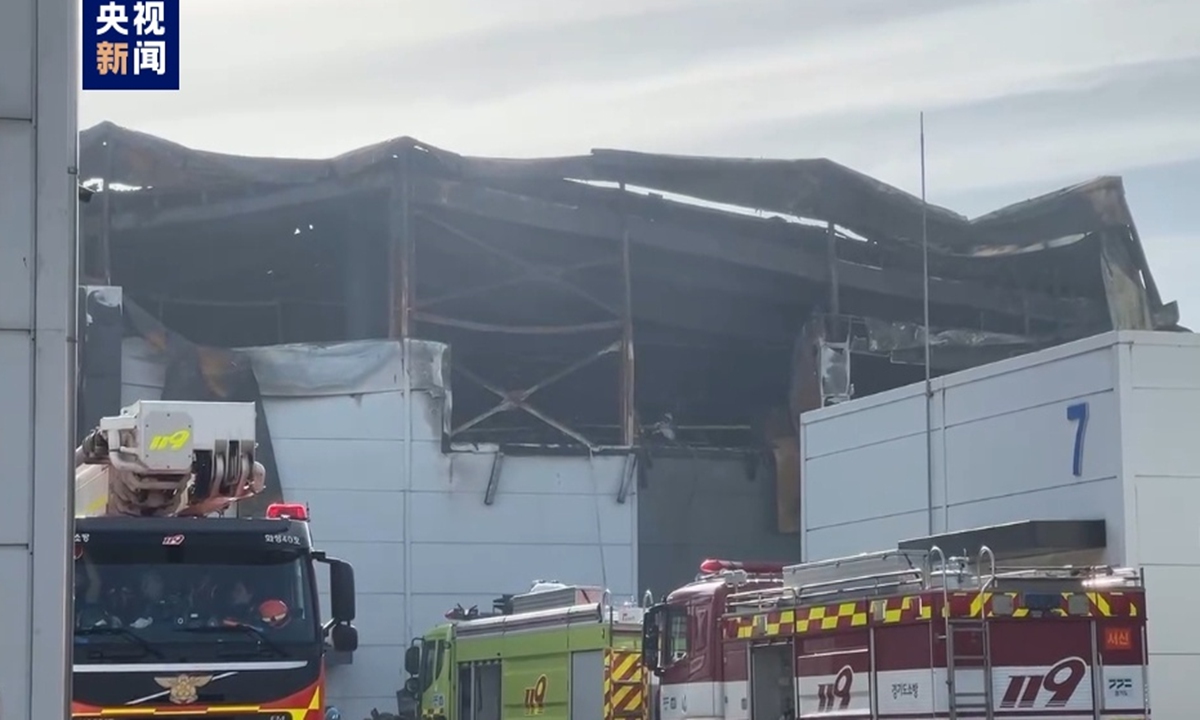Update: S.Korean plant fire kills 22, mostly Chinese nationals
Embassy in Seoul requests all-out efforts in handling accident

Firetrucks arrive at the fire scene at the lithium battery factory in South Korea on June 24, 2024. Photo: CCTV
Preliminary assessments indicate that 17 Chinese nationals have been killed in a fire at a lithium battery factory in South Korea, according to the Chinese embassy in South Korea. The exact number is awaiting further investigation. Following the accident, the Chinese embassy promptly activated emergency mechanisms, requesting all-out efforts to be made in rescuing the injured and managing the aftermath.
The fire at a lithiumion battery factory in Hwaseong, Gyeonggi Province on Monday morning killed 22 workers, injured eight and left one missing, according to the Chinese Embassy, citing South Korean authorities.
Among the 22 people who were killed, preliminary assessments indicate that 17 of them were Chinese nationals judging by their personal belongings. The exact number is awaiting further investigation, according to South Korean authorities. Among the eight injured individuals, one Chinese national sustained minor injuries.
On Monday night, Chinese Ambassador in South Korea Xing Haiming arrived at the scene of the fire and met with South Korean government officials and members of the fire department to understand the situation, progress made in search and rescue and follow-up arrangements. Ambassador Xing urged the South Korean side to quickly determine the cause of the accident, to handle the aftermath properly, and to provide all necessary support to the families of the Chinese victims.
"The fire has caused significant casualties and property loss, especially with multiple Chinese citizens tragically losing their lives. My heart is heavy with sorrow," Ambassador Xing told the media outlets onsite.
Xing said that the Chinese government is highly concerned about this incident and has instructed the Embassy to coordinate with relevant South Korean authorities to carry out rescue, aftermath, and investigation work. He also expressed his condolences to the victims' families and the injured.
"The Chinese Embassy in South Korea is working closely with South Korean authorities to do our utmost in handling the aftermath of the accident. I hope that the relevant South Korean companies will learn from this painful lesson and take effective measures to prevent similar accidents in the future and ensure the safety and health of Chinese citizens in South Korea," Xing said.
The factory that caught fire was a three-story building with a reinforced concrete structure and a gross floor area of more than 2,300 square meters. Approximately 35,000 lithium batteries were estimated to be stored on the second floor, according to media reports.
The lithium batteries emitted a large amount of smoke and burned rapidly, according to the person in charge of the fire department who participated in the rescue. The rescue team analyzed the onsite surveillance video as part of the preliminary investigation, according to CCTV.
It took only 15 seconds for the fire to go from white smoke to intense combustion, with smoke filling the entire area. Although employees at the scene tried to put out the fire with fire extinguishers after the incident, they were unable to control the fire.
A worker at the factory said there are more than 100 workers working at the factory, most of whom are ethnic Korean women between the ages of 30 and 40 from Northeast China. Most of the victims worked on the second floor of the battery factory, mainly in the battery packaging and welding workshops, according to The Beijing News.
After the accident, the Chinese embassy immediately activated emergency mechanisms, while Ambassador Xing contacted the governor of Gyeonggi, Kim Dong-yeon, requesting that all efforts be made to rescue and treat the victims and handle the accident properly. Kim agreed to assist the Chinese side in providing full assistance and properly handle the aftermath of the accident, according to a press release from the Chinese embassy on Monday.
The South Korean side has expressed its concern and condolences to the Chinese embassy. South Korean Prime Minister Han Duck-soo has also visited the scene and left instructions to communicate with the embassy and families of the casualties, and to take all measures to rescue the injured.
The cause of the fire is still being investigated. One of the workers who escaped from the fire told authorities that one of the batteries had exploded, Kim Jin-young, the head of the disaster prevention department at the Hwaseong Police Station said, according to local media reports.
A level two emergency response was also issued by the Gyeonggi Fire and Disaster Headquarters. A level two is issued for situations that require response from multiple fire stations from the area, according to local media reports.
Due to geographical proximity and cultural similarities, many Chinese, especially from the Korean ethnic group, choose to work in South Korea and have made significant contributions to the country's development, Lü Chao, a research fellow at the Liaoning Academy of Social Sciences, told the Global Times on Monday.
After this heartbreaking accident, the Chinese embassy and consulate will not only provide full assistance to the families of the victims, but also will urge the South Korean government to be more proactive in handling the accident, as well as rescue and compensation efforts, Lü said.
Many Chinese workers in South Korea are engaged in grassroots work, and their treatment in terms of wages and benefits is often not as good as that of local workers, with some not even signing formal labor contracts, he said. If there are victims who lack contract protection or official work status, local companies and governments should not treat them differently from local citizens in the aftermath of this incident, the expert stressed.

